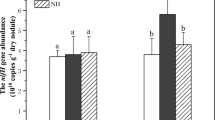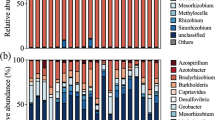Abstract
Species of the genera Polhillia, Wiborgia and Wiborgiella are endemic to the Cape fynbos, South Africa. These plants form root nodules with soil rhizobia that fix atmospheric nitrogen. Little is known about their N and P nutrition, as well as their water-use efficiency in this highly dry and nutrient-poor soil environment. Therefore, the aim of this study was to assess P nutrition and water-use efficiency in natural stands of Polhillia, Wiborgia and Wiborgiella species as well as their dependency on Biological N2 fixation for nutrition. The δ15N natural abundance technique was used to measure the symbiotic performance. The Acid and alkaline phosphatase activities were assayed using p-nitrophenol method. 16S rRNA sequence was used to identify microsymbionts nodulating the test plants. The δ15N study showed a high dependency of the tested species on N2 fixation. The N derived from fixation was 76–84% for Polhillia sps., 73–91% for Wiborgia sps., and 61–68% for Wiborgiella sessilifolia. The species differed in water-use efficiency, with δ13C values of −28.1 to −25.1‰ for Polhillia sps., −28.3 to −25.8 ‰ for Wiborgia sps., and − 27.7 to −27.1‰ for Wiborgiella sessilifolia. The rhizosphere acid and alkaline phosphatase activities were higher in P. brevicalyx and P. pollens, than in the other tested species and this resulted in greater available P in the rhizosphere soils and an increased P uptake and accumulation in the plant shoots. Based on 16S rRNA nucleotide sequence and phylogenetic analysis of root nodule isolates, a diverse and novel Mesorhizobium sps. nodulate the tested plant species in the fynbos ecosystem.



Similar content being viewed by others
References
Aremu BR, Alori ET, Kutu RF, Babalola OO (2017) Potentials of microbial inoculants in soil productivity: an outlook on African legumes. In: Microorganisms for Green Revolution. Springer, pp 53–75
Beukes CW, Venter SN, Law IJ, Phalane FL, Steenkamp ET (2013) South African papilionoid legumes are nodulated by diverse Burkholderia with unique nodulation and nitrogen-fixation loci. PLoS One 8:e68406
Beukes CW, Steenkamp ET, Van Zyl E et al (2019) Paraburkholderia strydomiana sp. nov. and Paraburkholderia steynii sp. nov.: rhizobial symbionts of the fynbos legume Hypocalyptus sophoroides. Antonie Van Leeuwenhoek 112:1369–1385
Beyers CPDL, Coetzer FJ (1971) Effect of concentration, pH and time on the properties of di-ammonium EDTA as a multiple soil extractant. Agrochemophysica 3:49–53
Boatwright JS, Tilney PM, Van Wyk B-E (2010) Taxonomy of Wiborgiella (Crotalarieae, Fabaceae), a genus endemic to the greater cape region of South Africa. Syst Bot 35:325–340
Brady NC, others (1990) Making agriculture a sustainable industry. Sustain Agric Syst 20–32
Chamier J, Schachtschneider K, Le Maitre DC et al (2012) Impacts of invasive alien plants on water quality, with particular emphasis on South Africa. Water SA 38:345–356
Cocks MP, Stock WD (2001) Field patterns of nodulation in fifteen Aspalathus species and their ecological role in the fynbos vegetation of southern Africa. Basic Appl Ecol 2:115–125
Cowling RM, McDonald DJ (1998) Local endemism and plant conservation in the cape floristic region. In: Landscape disturbance and biodiversity in Mediterranean-type ecosystems. Springer, pp 171–188
Cramer MD (2010) Phosphate as a limiting resource: introduction
Dludlu MN, Chimphango S, Stirton CH, Muasya AM (2017) Differential preference of Burkholderia and Mesorhizobium to pH and soil types in the Core cape subregion, South Africa. Genes (Basel) 9:2
Dludlu MN, Chimphango SBM, Walker G, Stirton CH, Muasya AM (2018) Horizontal gene transfer among rhizobia of the Core cape subregion of southern Africa. S Afr J Bot 118:342–352
Edgar RC (2004) MUSCLE: multiple sequence alignment with high accuracy and high throughput. Nucleic Acids Res 32:1792–1797. https://doi.org/10.1093/nar/gkh340
Elliott GN, Chen W-M, Chou J-H, Wang HC, Sheu SY, Perin L, Reis VM, Moulin L, Simon MF, Bontemps C, Sutherland JM, Bessi R, de Faria SM, Trinick MJ, Prescott AR, Sprent JI, James EK (2007) Burkholderia phymatum is a highly effective nitrogen-fixing symbiont of Mimosa spp. and fixes nitrogen ex planta. New Phytol 173:168–180
Farquhar GD, Ehleringer JR, Hubick KT (1989) Carbon isotope discrimination and photosynthesis. Annu Rev Plant Biol 40:503–537
Felsenstein J (1985) Confidence limits on phylogenies: an approach using the bootstrap. Evolution 39:783–791
Forest F, Colville JF, Cowling RM (2018) Evolutionary diversity patterns in the cape flora of South Africa. In: Phylogenetic Diversity. Springer, pp 167–187
Gerding M, O’Hara GW, Bräu L, Nandasena K, Howieson JG (2012) Diverse Mesorhizobium spp. with unique nodA nodulating the south African legume species of the genus Lessertia. Plant Soil 358:385–401. https://doi.org/10.1007/s11104-012-1153-3
Goldblatt P, Manning JC (2002) Plant diversity of the cape region of southern Africa. Ann Missouri Bot Gard 89:281–302
Hall T (2004) BioEdit version 7.0. 0. Distributed by the author, website: www.mbio.ncsu.edu/BioEdit/bioedit.html.2004
Herbien SA, Neal JL (1990) Soil pH and phosphatase activity. Commun Soil Sci Plant Anal 21:439–456
Hobbie SE (1992) Effects of plant species on nutrient cycling. Trends Ecol Evol 7:336–339
Howieson JG, De Meyer SE, Vivas-Marfisi A et al (2013) Novel Burkholderia bacteria isolated from Lebeckia ambigua--a perennial suffrutescent legume of the fynbos. Soil Biol Biochem 60:55–64
Kanu SA, Dakora FD (2012) Symbiotic nitrogen contribution and biodiversity of root-nodule bacteria nodulating Psoralea species in the cape Fynbos, South Africa. Soil Biol Biochem 54:68–76
Kimura M (1980) A simple method for estimating evolutionary rates of base substitutions through comparative studies of nucleotide sequences. J Mol Evol 16:111–120. https://doi.org/10.1007/BF01731581
Lemaire B, Dlodlo O, Chimphango S et al (2015) Symbiotic diversity, specificity and distribution of rhizobia in native legumes of the Core cape subregion (South Africa). FEMS Microbiol Ecol 91:2–17
Magadlela A, Kleinert A, Dreyer LL, Valentine AJ (2014) Low-phosphorus conditions affect the nitrogen nutrition and associated carbon costs of two legume tree species from a Mediterranean-type ecosystem. Aust J Bot 62:1–9
Maistry PM, Muasya AM, Valentine AJ, Chimphango SBM (2015) Increasing nitrogen supply stimulates phosphorus acquisition mechanisms in the fynbos species Aspalathus linearis. Funct Plant Biol 42:52–62
Manghabati H, Kohlpaintner M, Ettl R, Mellert K, Blum U, Göttlein A (2018) Correlating phosphorus extracted by simple soil extraction methods with foliar phosphorus concentrations of Picea abies (L.) H. Karst. and Fagus sylvatica (L.). J Plant Nutri Soil Sci. 181(4):547–56.
Maseko ST, Dakora FD (2013) Rhizosphere acid and alkaline phosphatase activity as a marker of P nutrition in nodulated Cyclopia and Aspalathus species in the cape fynbos of South Africa. S Afr J Bot 89:289–295. https://doi.org/10.1016/j.sajb.2013.06.023
Maseko ST, Dakora FD (2015) Nitrogen nutrition, carbon accumulation and δ13C of Cyclopia and Aspalathus species in different settings of the cape fynbos, South Africa. J Plant Ecol 9:586–595
Mbah GC, Dakora FD (2017) Nitrate inhibition of N 2 fixation and its effect on micronutrient accumulation in shoots of soybean (Glycine max L. Merr.), Bambara groundnut (Vigna subterranea L. Vedc) and Kersting’s groundnut (Macrotyloma geocarpum harms.). Symbiosis 1–12
Meadows ME (2006) Global change and southern Africa. Geogr Res 44:135–145
Mpai T, Jaiswal SK, Dakora FD (2016) Biological nitrogen fixation and molecular diversity of rhizobia isolated from root nodules of wild legumes: Polhillia, Wiborgia and Wiborgiella species of the south African cape fynbos. South African J Bot 100(103):336
Muofhe ML, Dakora FD (1999) Nitrogen nutrition in nodulated field plants of the shrub tea legume Aspalathus linearis assessed using 15N natural abundance. Plant Soil 209:181–186
Nannipieri P, Giagnoni L, Landi L, Renella G (2011) Role of phosphatase enzymes in soil. In: Phosphorus in action. Springer, pp 215–243
Post DM, Layman CA, Arrington DA, Takimoto G, Quattrochi J, Montaña CG (2007) Getting to the fat of the matter: models, methods and assumptions for dealing with lipids in stable isotope analyses. Oecologia 152:179–189
Power SC, Cramer MD, Verboom GA, Chimphango SBM (2010) Does phosphate acquisition constrain legume persistence in the fynbos of the cape floristic region? Plant Soil 334:33–46
Richardson AE, Simpson RJ (2011) Soil microorganisms mediating phosphorus availability update on microbial phosphorus. Plant Physiol 156:989–996
Saitou N, Nei M (1987) The neighbor-joining method : a new method for reconstructing phylogenetic trees. Mol Biol Evol 4:406–425
Shearer G, Kohl DH (1986) N2-fixation in field settings: estimations based on natural 15N abundance. Funct Plant Biol 13:699–756
Somasegaran P, Hoben HJ (2012) Handbook for rhizobia: methods in legume-Rhizobium technology. Springer Science & Business Media
Spriggs AC, Dakora FD (2009) Field assessment of symbiotic N2 fixation in wild and cultivated Cyclopia species in the south African fynbos by 15N natural abundance. Tree Physiol 29:239–247
Stirton CH (1986) Polhillia, a new genus of papilionoid legumes endemic to South Africa. S Afr J Bot 52:167–180
Tabatabai MA (1994) Soil enzymes. Methods soil anal part 2 microbiological biochemical properties 775–833
Tamura K, Stecher G, Peterson D, Filipski A, Kumar S (2013) MEGA6: molecular evolutionary genetics analysis version 6.0. Mol Biol Evol 30:2725–2729. https://doi.org/10.1093/molbev/mst197
Tarafdar JC, Yadav RS, Meena SC (2001) Comparative efficiency of acid phosphatase originated from plant and fungal sources. J Plant Nutr Soil Sci 164:279–282
Unkovich M, Herridge D, Peoples M, et al (2008) Measuring plant-associated nitrogen fixation in agricultural systems. Australian Centre for International Agricultural Research (ACIAR)
Vincent JM (1970) A manual for the practical study of root-nodule Bacteria. Blackwell Scientific, Oxford
Zinga MK, Jaiswal SK, Dakora FD (2017) Presence of diverse rhizobial communities responsible for nodulation of common bean ( Phaseolus vulgaris ) in south African and Mozambican soils. FEMS Microbiol Ecol 93:fiw236. https://doi.org/10.1093/femsec/fiw236
Acknowledgments
We are grateful to the South African Research Chair in Agrochemurgy and Plant Symbioses, the National Research Foundation, and the Tshwane University of Technology for financial support to FDD’s research, and for a SARCHI Chair Master’s bursary to TM.
Author information
Authors and Affiliations
Corresponding authors
Additional information
Publisher’s note
Springer Nature remains neutral with regard to jurisdictional claims in published maps and institutional affiliations.
Rights and permissions
About this article
Cite this article
Mpai, T., Jaiswal, S.K. & Dakora, F.D. Accumulation of phosphorus and carbon and the dependency on biological N2 fixation for nitrogen nutrition in Polhillia, Wiborgia and Wiborgiella species growing in natural stands in cape fynbos, South Africa. Symbiosis 81, 65–78 (2020). https://doi.org/10.1007/s13199-020-00683-y
Received:
Accepted:
Published:
Issue Date:
DOI: https://doi.org/10.1007/s13199-020-00683-y




